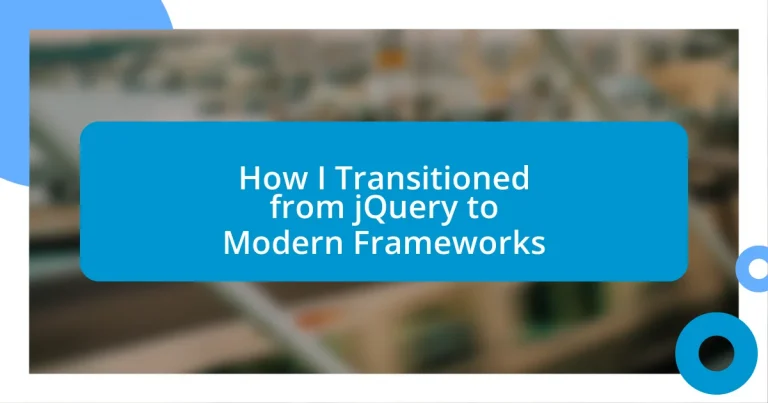Key takeaways:
- Transitioning from jQuery to modern frameworks revealed jQuery’s limitations in larger projects, particularly in global namespace conflicts and performance issues.
- Exploration of frameworks like React, Angular, and Vue.js highlighted advantages such as component-based architecture, reactive data binding, and a rich ecosystem for development.
- Strategic planning, including setting achievable milestones and engaging with community resources, was essential for a smooth transition and successful implementation of new frameworks.
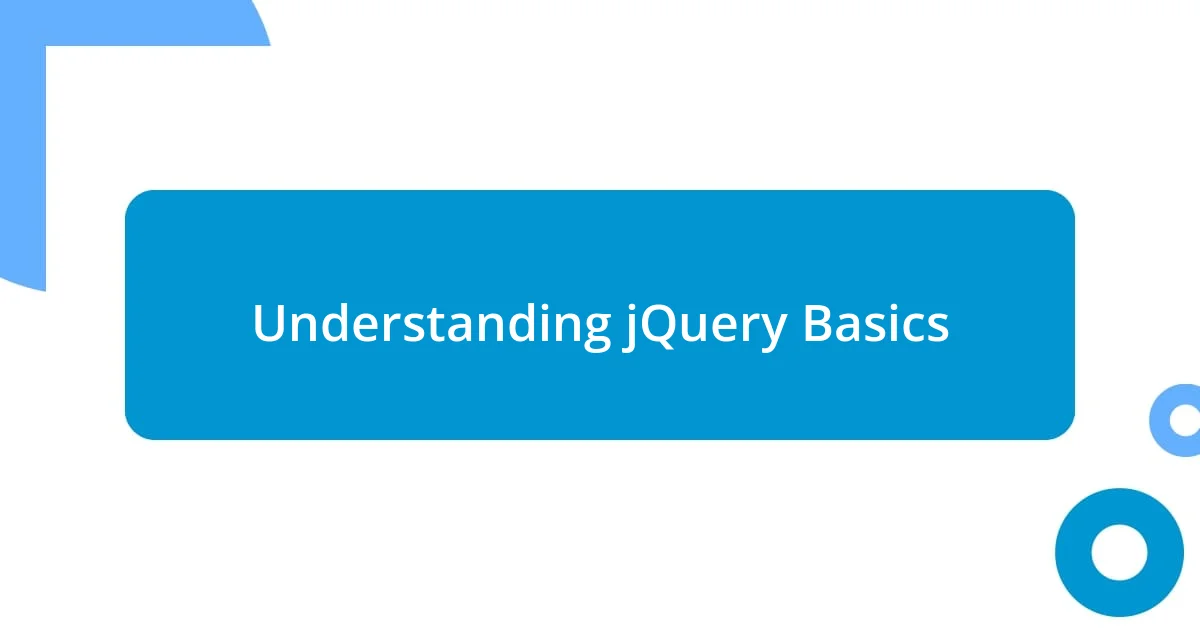
Understanding jQuery Basics
When I first dived into jQuery, I was struck by its simplicity. The way it wrapped up complex JavaScript functions into easy-to-use shortcuts was like a breath of fresh air. I remember the thrill of selecting elements with just a few characters—$('selector')—and feeling like I had superpowers at my fingertips!
As I began to experiment with jQuery, I realized its powerful manipulation capabilities could create dynamic user experiences with minimal code. I particularly enjoyed utilizing the .animate() function to add finesse to my websites. Have you ever watched your design come to life with just a few lines of jQuery? It was genuinely exciting, igniting my passion for web development.
However, as much as I adored jQuery for its ease and utility, I also sensed its limitations when it came to building more complex applications. The moment I tried integrating jQuery with larger codebases, I found myself wrestling with readability and maintainability. At that point, I began to question: could there be a more streamlined approach to handling complex interactions without sacrificing performance? This curiosity eventually led me to explore modern frameworks, and let me tell you, the journey was incredibly enlightening!
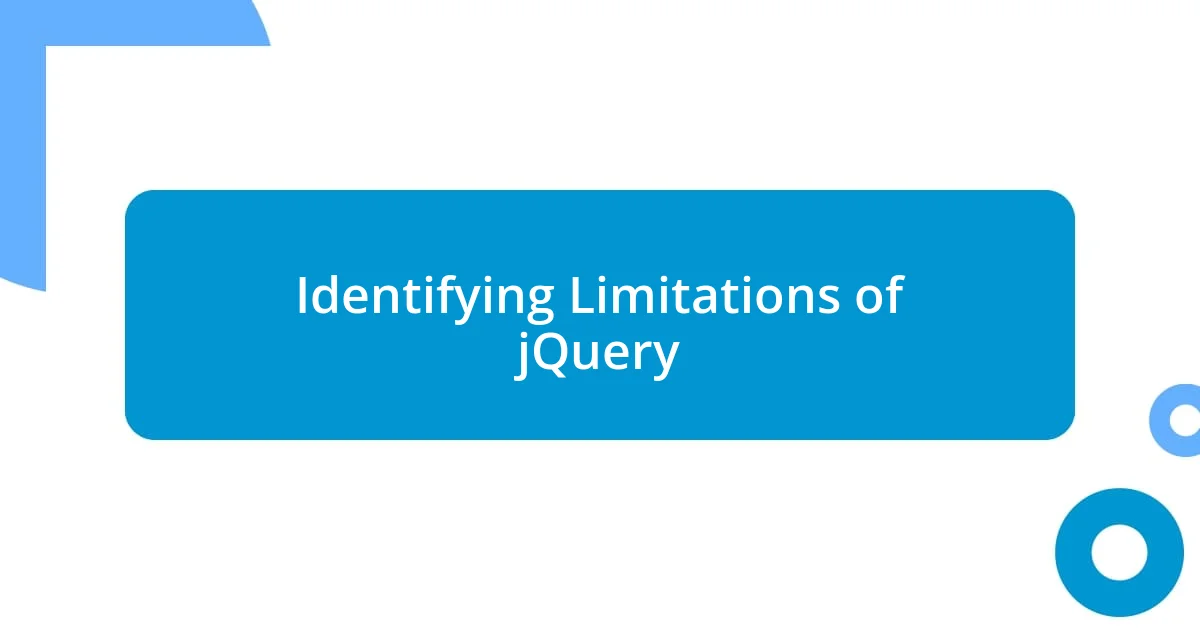
Identifying Limitations of jQuery
I quickly found that jQuery’s reliance on a global scope often led to conflicts in larger projects. The moment I introduced multiple plugins, it felt like I was walking a tightrope—balancing functionality against inevitable JQuery clashes. I remember staring at my monitor in frustration as a simple task turned into an endless debugging session, simply because two plugins were stepping on each other’s toes.
Another limitation I faced was performance. While jQuery is excellent for DOM manipulation, it’s not optimized for modern development where speed is crucial. I recall a particular project where the loading time skyrocketed due to excessive jQuery function calls, making me realize that relying solely on it could hinder rather than help the user experience. This drove me to search for alternatives that could more efficiently handle intensive operations.
Lastly, I noticed a lack of support for reactive programming principles in jQuery. My attempt to implement a responsive interface felt like trying to fit a square peg into a round hole. I remember a time when I attempted to create dynamic content updates based on user interactions, only to realize that jQuery’s model fell short in managing state changes efficiently. Frustrated, I decided it was time to explore modern frameworks that embraced state management, ultimately enhancing both my code quality and user experience.
| Aspect | jQuery |
|---|---|
| Global Namespace | Prone to conflicts in larger projects |
| Performance | Slow with excessive DOM manipulations |
| Reactive Programming | Lacks robust state management features |
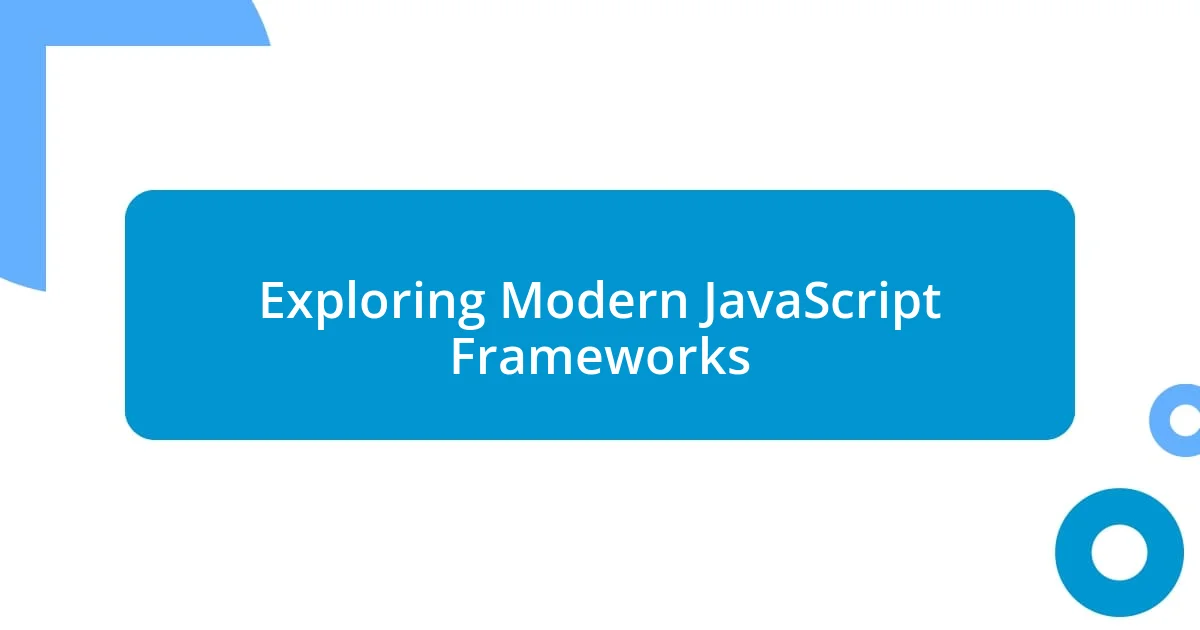
Exploring Modern JavaScript Frameworks
When I first stepped into the world of modern JavaScript frameworks, it was like entering a vibrant and dynamic marketplace buzzing with possibilities. The transition was exhilarating, as I discovered frameworks like React, Angular, and Vue.js—each offering unique benefits. I remember the first time I built a small app using React; the component-based architecture felt intuitive and empowering. It was refreshing to organize my code logically, allowing me to focus on building rather than wrestling with tangled jQuery.
Here are some standout features that fueled my excitement during this exploration:
- Component-Based Architecture: Breaking down UI elements into reusable components simplifies code management and enhances collaboration.
- Reactive Data Binding: Modern frameworks automatically update the UI when data changes, creating a seamless user experience.
- Rich Ecosystem: A wide array of libraries and tools available for modern frameworks enhances development speed and ease.
As I delved deeper, I quickly appreciated the importance of community support and resources—all crucial for learning and growing as a developer. Attending a local meetup, I connected with others who were just as passionate about frameworks, sharing stories and coding practices that broadened my perspective. It’s moments like these that create a sense of camaraderie—reminding me that I’m part of something bigger and more innovative than I ever realized while using jQuery.
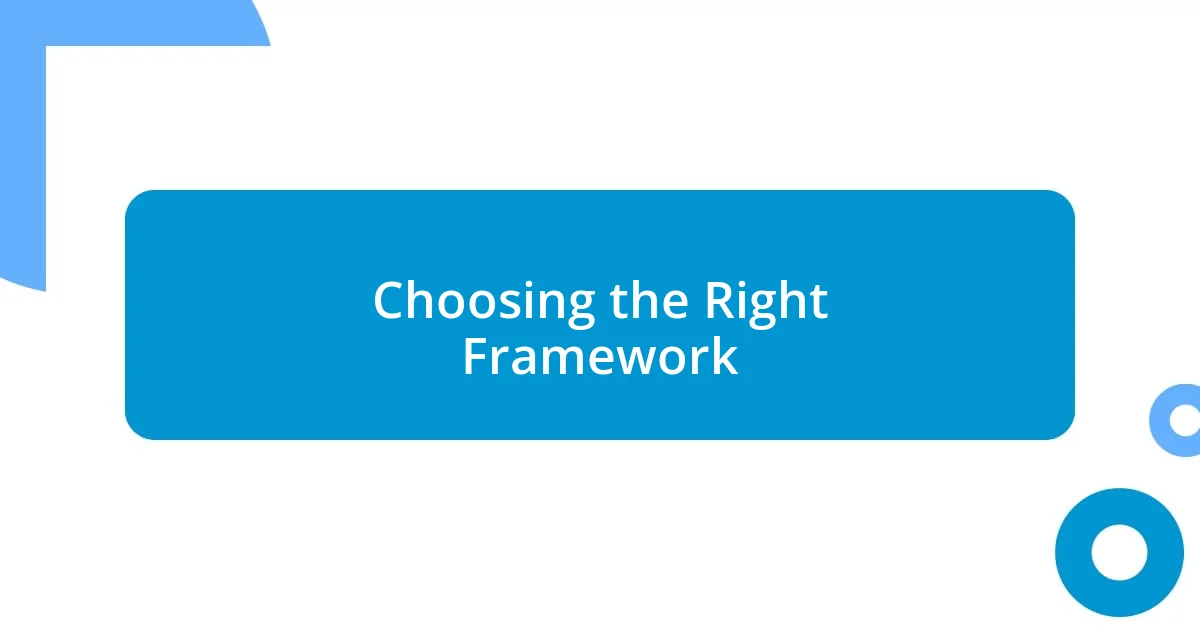
Choosing the Right Framework
Choosing the right framework can feel overwhelming with so many options available. I remember sitting in front of my screen, comparing features like performance, community support, and ease of learning. It struck me that choosing a framework isn’t just about the technology—it’s about how it aligns with my goals and the type of projects I want to build. How do I want my coding experience to feel? I wanted something that could grow with me, yet still be efficient for smaller projects.
As I navigated through frameworks, I realized the importance of considering my existing skill set. For instance, when I encountered Vue.js, I was struck by its gentle learning curve, which reminded me of jQuery’s simplicity. But unlike jQuery, it offered powerful features like reactive data-binding, which made it feel like there was a safety net to catch my coding errors. Have you ever found yourself leaning towards a tool that just feels right? That’s how Vue.js resonated with me—I found comfort in its approachable syntax while still feeling challenged.
Ultimately, my decision came down to practical use cases and personal preferences. I sought a framework that not only met my immediate needs but also challenged me to grow as a developer. That’s where tools like React’s component-based architecture came into play. It was like assembling a puzzle where every piece had its place, and I found immense satisfaction in creating scalable, maintainable applications. Engaging with these frameworks wasn’t just a technical shift; it felt like a journey of discovery that reshaped not only my projects but also my approach to coding.
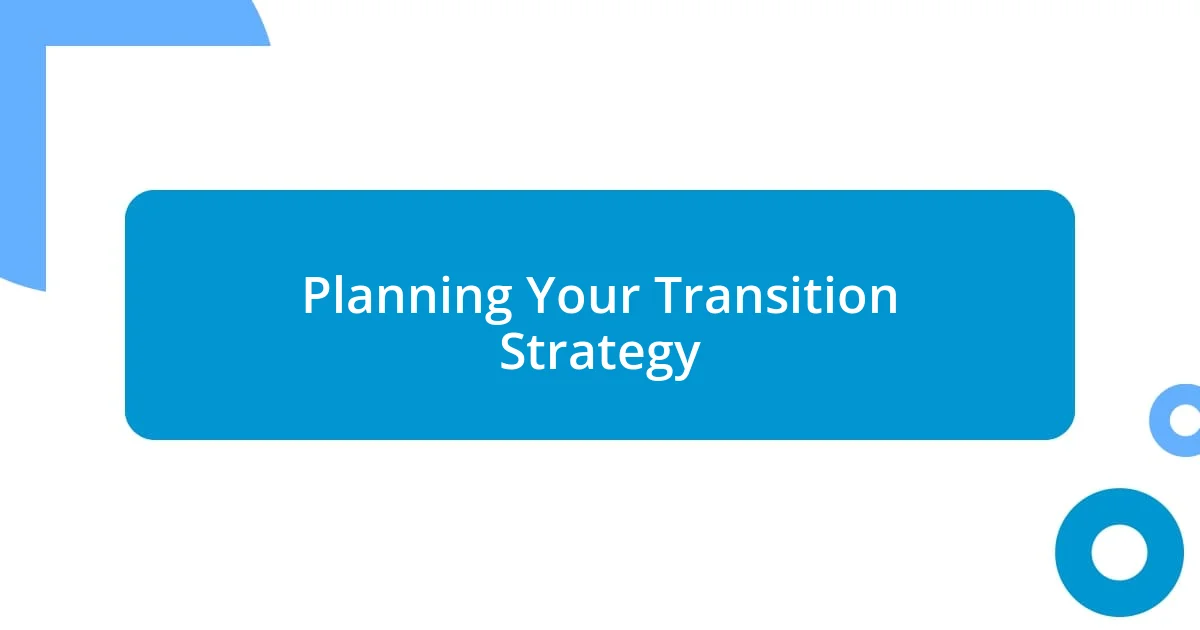
Planning Your Transition Strategy
When planning your transition strategy, I found it helpful to start with a clear roadmap. I created a list of the projects that mattered most to me, identifying which frameworks aligned with each project. This method not only kept me organized but also tailored my learning experience—it felt less overwhelming when I could focus on one framework at a time, and it made each success feel like a small victory.
I also learned the value of setting achievable milestones. Initially, I would aim to convert a small part of an existing jQuery project into a modern framework feature. It was exciting to witness that first component come to life in React. Have you ever felt that rush when you see your code work flawlessly after a bit of struggle? That feeling of progress fueled my motivation to keep going.
Another essential aspect was community engagement. I made it a point to participate in online forums and local meetups dedicated to these frameworks. Sharing my challenges and victories not only provided support but also opened doors to invaluable resources. Isn’t it reassuring to know others have faced similar hurdles? Building connections with fellow developers helped me see my journey as part of a broader learning community—something that truly enriched my transition.
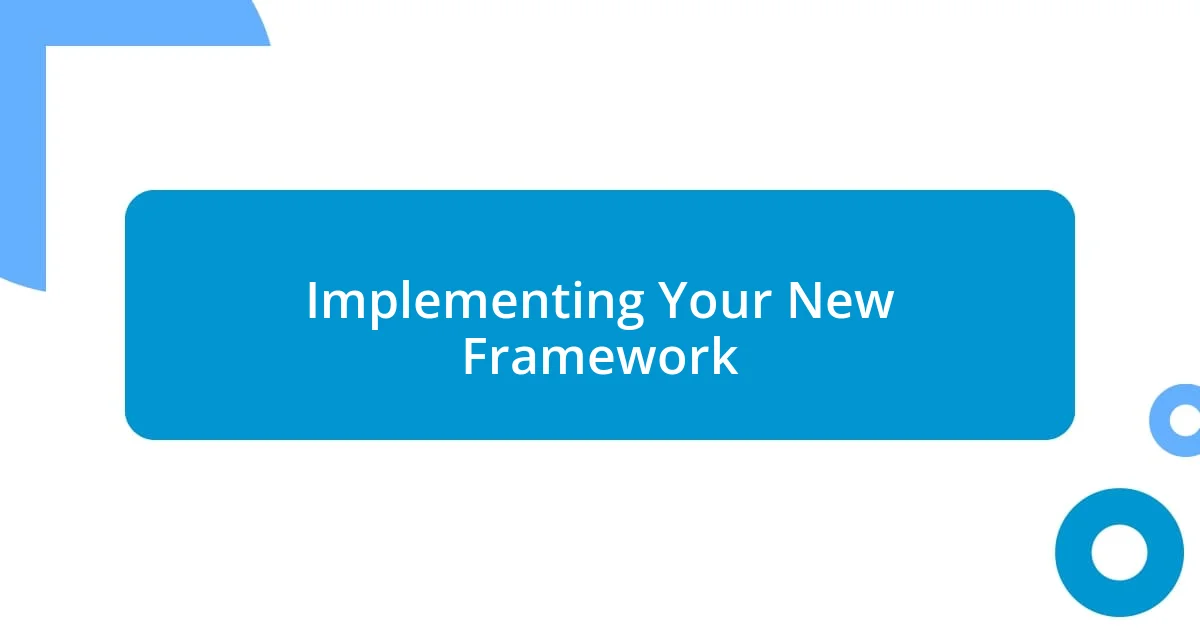
Implementing Your New Framework
As I dove into implementing my new framework, the excitement was palpable. I vividly remember the first time I set up my environment for React; it felt like unlocking a treasure chest of possibilities. Each line of code felt charged with potential. I began by creating simple components, relishing the process of watching my ideas take shape on the screen. Have you ever felt that immediate connection with your code? It’s a rush of creativity that makes the learning curve worth every ounce of effort.
Once I settled on the structure, I focused on integrating it with some of my existing projects. I chose a small feature to migrate, which surprisingly highlighted the differences and advantages of the new framework. For example, implementing state management in React allowed for a more dynamic and responsive user experience than I was used to with jQuery. That realization hit me hard—what once felt cumbersome now felt fluid and intuitive.
Finally, I can’t stress enough the importance of continuous testing as I implemented my new framework. I learned that by frequently running tests, I could catch errors and understand the behavior of my application more deeply. The early days were often filled with trial and error, which tested my patience at times. But slowly, every bug fixed brought clarity. Did you know that each correction can feel like a mini-conquest? Letting yourself celebrate those little victories fuels your journey, creating a natural momentum that’s hard to resist.












